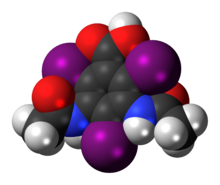Diatrizoate meglumine
 |
|
 |
|
| Clinical data | |
|---|---|
| Trade names | Hypaque, Gastrografin, Iothalmate, Urografin, others |
| Synonyms | amidotrizoic acid, diatrizoic acid, 3,5-diacetamido-2,4,6-triiodobenzoic acid |
| AHFS/Drugs.com | Micromedex Detailed Consumer Information |
| Identifiers | |
|
|
| CAS Number | |
| PubChem CID | |
| DrugBank | |
| ChemSpider | |
| KEGG | |
| ChEBI | |
| ChEMBL | |
| ECHA InfoCard |
100.003.840 |
| Chemical and physical data | |
| Formula | C11H9I3N2O4 |
| Molar mass | 613.92 g·mol−1 |
| 3D model (JSmol) | |
|
|
|
|
Diatrizoate, also known as amidotrizoate, is a contrast agent used during X-rays. This includes when visualizing veins, the urinary system, spleen, and joints, as well as during computer tomography (CT scan). It is given by mouth, injection into a vein, injection into the bladder, or rectally.
Relatively common side effects include vomiting, diarrhea, and skin redness. Other side effects include itchiness, kidney problems, low blood pressure, and allergic reactions. It is not recommended in people who have an iodine allergy. Diatrizoate is an iodinated ionic radiocontrast agent with high osmolality.
Diatrizoate was approved for medical use in the United States in 1954. It is on the World Health Organization's List of Essential Medicines, the most effective and safe medicines needed in a health system. The wholesale cost in the developing world is about 5.49 USD per 20 ml vial. In the United States a dose costs less than 25 USD.
Diatrizoic acid may be used as an alternative to barium sulfate for medical imaging of the gastrointestinal tract, such as upper gastrointestinal series and small bowel series. It is indicated for use in patients who are allergic to barium, or in cases where the barium might leak into the abdominal cavity. It does not coat the stomach/bowel lining as well as barium, so it is not used commonly for this purpose.
...
Wikipedia
